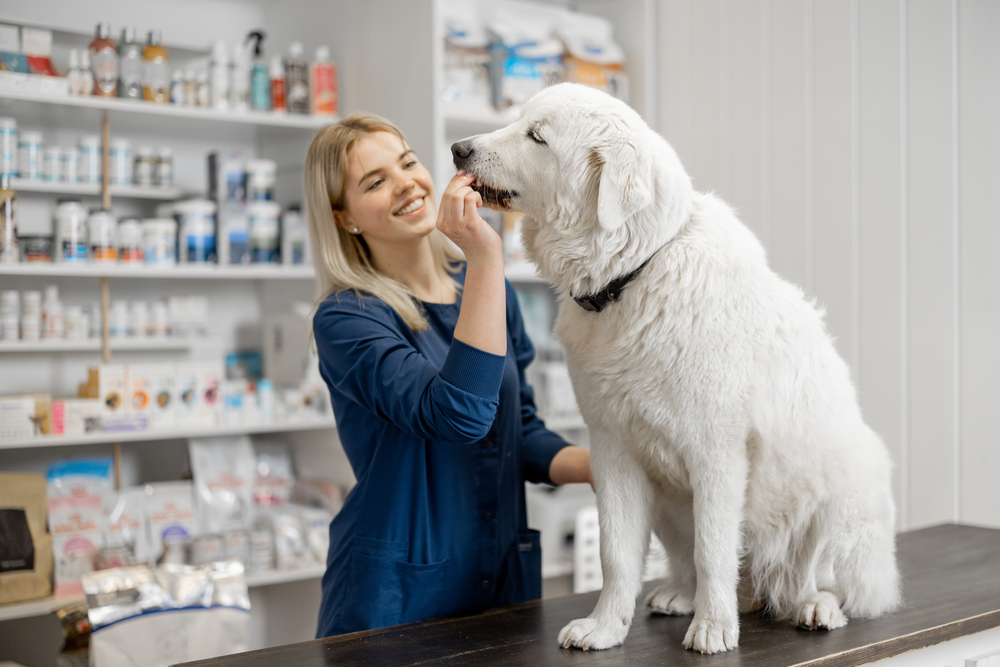Hip dysplasia is the most common orthopedic condition that affects medium- and large-breed dogs, making the condition a frequent topic between concerned dog owners and our Juanita Hills Animal Hospital team. To help you understand this potentially debilitating disease—including how to prevent or slow its progression—we’ve compiled the most common questions and our answers in this easy-to-use guide.
Question: What is canine hip dysplasia?
Answer: Canine hip dysplasia is a degenerative orthopedic disease in which the hip joint becomes increasingly lax or loose. While a normal hip joint has a snug-fitting ball and socket structure that promotes smooth and easy range of motion, a dysplastic hip is misshapen, displaced, and unstable. This leads to grinding, difficult and painful movement, and hind limb muscle atrophy (i.e., loss).
Q: What causes hip dysplasia in dogs?
A: Hip dysplasia is caused by multiple interrelated factors, including genetics, environmental factors during development, and early nutrition. While all puppies have normal hip joints at birth, these three factors disrupt appropriate growth and create laxity shortly after birth and result in instability, weakness, and eventually chronic pain.
Q: How can I prevent hip dysplasia in my new puppy?
A: Unfortunately, because genetics play the largest role in hip dysplasia development, prevention is virtually impossible. However, puppy owners can take many proactive safety measures that can decrease their young dog’s risk for severe orthopedic disease. These include:
- Bringing your puppy for a veterinary exam — Your veterinarian can palpate your puppy’s hips and use a method called the Ortolani sign to determine if their hips are lax.
- Feeding tailored nutrition for growth and development — Excessive vitamins and minerals can lead to rapid bone growth and alter joint congruity (i.e., fit). Large-breed puppy diets are specially formulated for slow, controlled growth.
- Feeding a portion-controlled diet — Your veterinarian can help you determine how much to feed your puppy at each development phase. This avoids feeding excessive calories, which can lead to weight gain and unnecessarily straining growing hips.
- Keeping your puppy on non-slip flooring — Better grip reduces slipping and falling, which can damage the hips and increase laxity.
- Playing age-appropriate games and limiting physical challenges — Gentle, controlled activity promotes strength and coordination without risking injury to developing joints. Growing puppies should not participate in activities that include jumping, sharp turns, and repetitive movement.
Q: What are hip dysplasia signs in dogs?
A: The age when hip dysplasia signs become visible depends on disease severity, progression, and the dog’s pain tolerance. While some puppies experience significant mobility impairment because of their unstable hips, others may not experience clinical disease until their senior years, when secondary arthritis causes stiffness and pain.
Common signs among both groups include:
- Limping or favoring a limb, especially after activity
- Bunny-hopping (i.e., moving both hind legs at the same time)
- Exercise intolerance
- Reluctance to jump on or use stairs
- Difficulty rising from a sitting or lying position
- Hip pain or tenderness, especially on extension
- Muscle atrophy in the thighs and lower back
Q: Will my dog need surgery?
A: Several surgical procedures are available for dogs with hip dysplasia, but you must carefully consider the risks and benefits to ensure the best possible outcome.
Your veterinarian will use your dog’s hip X-rays to grade your dog’s hip dysplasia based on their joint conformation (i.e., structure), bone remodeling (i.e., the body’s attempt to adapt to inappropriate movement), and the presence or absence of arthritis. This information, along with your dog’s breed, age, and clinical signs, will determine their candidacy for surgery and the appropriate procedure. The goal is to surgically repair or reconstruct the dog’s joint to eliminate their pain.
Q: Are there non surgical treatment options for canine hip dysplasia?
A: While surgery can restore healthy pain-free movement for severely affected dogs, conservative (i.e., medical) management can provide increased comfort, independence, and longevity for dogs who are not surgical candidates because of age, cost, or other factors.
The goal of conservative management is to control pain and inflammation and slow disease progression through medication, lifestyle modification, weight management, and various rehabilitative therapies (e.g., laser therapy).
Q: How can I help my dog live a comfortable life with hip dysplasia?

A: Watching your dog struggle with hip dysplasia can be a helpless feeling but, fortunately, you can support your four-legged friend’s mobility and wellbeing. We recommend the following:
- Attending regular wellness visits — Your dog’s pain level and mobility needs will change over time. Regular veterinary visits ensure that our team can control your dog’s pain and advise you on exercise and nutrition needs.
- Keeping your dog at a lean healthy weight — Feed your dog a portion-controlled balanced diet to avoid harmful weight gain.
- Providing a supportive resting place — Orthopedic dog beds provide even support and cushioning for painful joints.
- Installing pet ramps — Help your dog avoid painful jumping or climbing with gentle ramps.
- Maintaining regular low-impact exercise — Appropriate exercise (e.g., walking, swimming, hydrotherapy) prevents muscle atrophy, maintains hip range-of-motion, keeps joints lubricated and flexible, burns calories, promotes healthy sleep, and improves mental wellbeing.
Hip dysplasia can limit your dog’s range of motion, but not their life. From diagnosis to day-to-day care, the Juanita Hills Animal Hospital team provides personalized veterinary care at each visit. We’ll walk you through each step, so you can feel confident and informed about each stage of your dog’s condition.
Contact our caring team to schedule your pet’s appointment or to request additional information about hip dysplasia in dogs and all our services.



















Leave A Comment